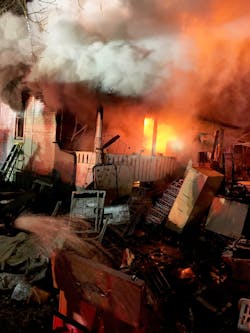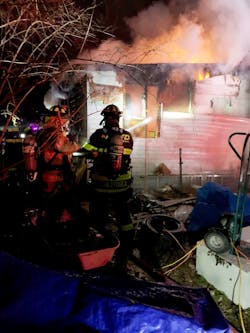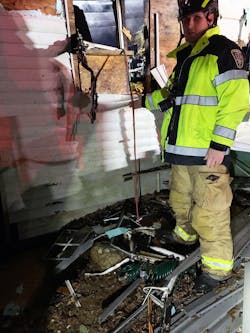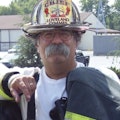Close Calls: Victim Trapped in Hoarding Conditions
Incident commanders must embrace the possibility that they might need to stop attempts at entry of houses that show exterior and interior signs of massive cluttering.
The line-of-duty death of FDNY Lt. Gordon Ambelas on July 5, 2014, on scene of a fire in a 19th-floor apartment that was piled with “stuff” reflects a nationwide uptick in fire calls that are complicated by clutter conditions.
The American Psychiatric Association estimates that as much as 6 percent of the population has hoarding disorder. A WebMD article explains that a hoarder finds it painful to let go of things, so they never do.
I mention these things because it often is easy for firefighters to quickly judge conditions when we arrive on a run, including EMS runs. We must understand that hoarding very well might be a behavioral health issue. With that said, it absolutely adds to the risk that we often must take and is critical in our size-up and ongoing operations.
Our thanks to Deerfield Township, OH, Fire Rescue (DTFR) Chief of Department Chris Eisele, Deputy Chief Dan James, Deputy Chief Doug Wehmeyer, and their officers and members for their assistance in providing the information for this close call. Additional thanks to the officers and members of Hamilton Township Fire Rescue, the City of Mason Fire Department, the Loveland-Symmes Fire Department and Union Township Fire Rescue who were part of the first alarm.
The incident
At 10:42 p.m. on Feb. 5, 2021, a one-alarm fire was dispatched for a dwelling fire with reported occupants trapped. The first alarm brought DTFR Ladder 57, Engine 56 and Engine 58, Loveland-Symmes Tower 61, Mason Ladder 52, Hamilton Township Engine 76 and Ladder 77 as well as EMS units from DTFR and Union Township. Five chief officers also were due with DTFR Battalion 56 (James as the incident commander).
Battalion 56 arrived and transmitted a working fire in a small, single-story, single-family dwelling, with heavy fire and smoke throughout. Neighbors confirmed to James that a victim likely was inside. The exterior around the house had holes that were several feet deep as well as boats, automobiles, tents and power tools. First-alarm companies made numerous attempts at rapid entry, but it was impossible because of hoarding conditions inside and out.
The area was hydranted. Two 5-inch supply lines were laid out; water supply was instant. All companies positioned themselves well for water supply but also so that EMS would have access in and out.
Within moments of arrival, power lines dropped, and command ordered a defensive attack. (A construction “add on” appeared to be well outside of code requirements, and noncode power connections in the area also represented hazards.)
Power was secured by the power company, but because of the noncode power connections, there was a close call following that. Fortunately, all members were safe/secure, and the power company re-inspected the area to ensure that all areas were shut down.
The victim was found on the Bravo side near the Charlie side about 15 feet in toward the Alpha side. Initial indications are that the 52-year-old victim perished well before fire department arrival.
Observations
Firehouse Contributor Capt. Ryan Pennington has researched and written much on this subject.
“Understanding and communicating that firefighters are unable to enter the house because of heavy clutter must be communicated to the entire fire scene so adjustments can be made,” Pennington says. “Fire commanders should use the path of least resistance to try to make entrance, because these are the entry points that the occupant will use. Although well-established, these pathways might be uncommonly located.”
Just like any response, fighting fires in hoarder houses starts with a scene size-up to observe different areas for clues. A lot of these houses have cluttered yards or derelict automobiles out front, as clearly was the case with the DTFR fire. Take a quick peek into any windows that allow an interior view. You might know that you have a problem when you get to the door and it only will open slightly. With the utilization of these quick observations, coupled with the reading of smoke conditions, a first-due officer can make the determination between an offensive attack and a defensive attack.
While sizing up, consider structural integrity. Most hoarder houses are in disrepair and have substantial added weight that stresses structural members. This is prevalent particularly regarding lightweight wood-frame construction. That was the case with the DTFR house. Also keep in mind the stress that water will add to the already weighed-down structural members.
A first-arriving officer should wait until a hydrant line is established before entering the environment. Even the largest booster tanks don’t have enough water to absorb this heat. While waiting on the water supply, the first attack line may elect to find the room that’s closest to the seat of the fire and use an indirect attack. This should help to reduce the size and spread of the fire. The second consideration: point of entry. In hoarder houses, walkways are limited, which can increase the labor that’s required to manage even the smallest-diameter attack line. The advancing attack team might need to knock over smaller piles of belongings to make their advance to the seat of the fire.
As a hoseline is advanced through pathways, it might knock over debris. People have been killed by the collapse of these belongings when dry; imagine how heavy they are when wet. It is imperative that the backup firefighter works to keep this from happening. In a perfect world, an interior attack team would go to a three-firefighter crew, with the third person responsible for removing or moving debris if it falls on the hose. (A debris collapse will make the hoseline heavier and more difficult to move.) All members must keep in mind the ever-changing environment.
Lessening the danger
While the first line is being advanced, the outside crews can aid in the safety. In hoarder houses, vertical ventilation might be more important than it typically can be. Fire that spreads along the ceiling of these houses can catch the piles of belongings faster because of their height. Horizontal spread, coupled with the increased fuel load, can make a flashover occur sooner and at a lower temperature than normal.
That said, Pennington notes to keep in mind that the attic is commonly the first place that the collections of stuff starts. “I suggest instead of committing members to vent, use them to soften the structure and cut down windows into doors until a look can be made interior and determine whether the attic is full,” Pennington explains.
Through the cut-down windows, some of the piles can be pulled outside. This allows for a better means of secondary egress for interior crews. A New York hook or Boston rake might be the tool of choice in this circumstance; they allow a longer reach and a better hold on items.
Communication between attack crew, outside ventilation crew and incident commander should happen more often and be as direct as possible because of the increased work and increased fuel load on the interior crews.
If conditions are to the point that an interior attack isn’t tenable, it’s best to pull crews out and regroup. Once outside, you must consider the normal worries of collapse zone but also be aware of other considerations that are specific to this type of fire. Because of the compression and density of the conditions, opening windows and cutting them to the floor and breeching exterior walls can increase your reach with master streams and handlines.
It will take more volume of water to put out these fires, and stream penetration is a key factor. A solid stream or smooth bore nozzle is preferred because of the stream shape and capability to penetrate the piles of belongings. Portable monitors might aid in your operation. The capability to apply a large gpm while using minimal amounts of staffing allows you to reassign members to help make access points and use more lines.
Final thoughts
Although strong attempts were made by DTFR members to search for the occupant of the house, ultimately, it was impossible. As was well-stated by one fire officer at the fire, “We train our entire career to get people out, and in this case, it was the victim who created the impossible conditions.”
Privacy laws and red tape prevent government authorities from fully knowing or understanding the dangers of their buildings and neighborhoods. Fire departments can inspect commercial structures, but they often are powerless to check residences for hazards.
“Firefighters need to use the EMS runs and learn the cues from the exterior to reduce the number of ‘hidden hoarders’ discovered during a fire,” Pennington says.
In fact, in this case specifically, Deerfield Township had declared the house a nuisance property some six months earlier. The property owner received 30 days to abate the hazards and requested an additional 30 days about six weeks later.
Although community risk management and fire prevention personnel can and should do as much as possible to reduce these hazards, leaders must focus on training firefighters for these calls and their potential for more intense heat and faster-spreading fire.
The FDNY recreates cluttered conditions at its fire academy and updates firefighters and command officers on the latest operations and tactics. The NFPA offers training on hoarding, and Firehouse.com has several training articles by Pennington, including, most recently, “Tactical Considerations for Hoarding Fires.”
“Hoarder homes are popping up in everyone’s district all across the country,” Pennington says. “Sooner or later, you will be the one tasked with fighting these fires.
“These types of fires can be firefighter killers in an instant,” he adds. “Remember, when faced with this type of challenge, the best tactic might be not to go in. It’s one of the hardest decisions a firefighter will have to make.”
That’s exactly what James had to do at this fire. After his continued size-up, allowing companies to give it “their all,” the quickly changing conditions indicated that members no longer could be allowed to attempt entry. A very difficult call by James, but one that clearly reduced any further injury or death at this fire.
Hoarder House Salvage and Overhaul
A big concern with the overhaul of a hoarder house is the person’s connection to the belongings and, thus, having to deal with the person/owner. The individual might need to be removed by law enforcement, so piles can be sorted, and fire can be extinguished. While sorting through the belongings, remember the old adage that “one man’s junk, is another man’s treasure.”
About the Author
Billy Goldfeder
BILLY GOLDFEDER, EFO, who is a Firehouse contributing editor, has been a firefighter since 1973 and a chief officer since 1982. He is deputy fire chief of the Loveland-Symmes Fire Department in Ohio, which is an ISO Class 1, CPSE and CAAS-accredited department. Goldfeder has served on numerous NFPA and International Association of Fire Chiefs (IAFC) committees. He is on the board of directors of the IAFC Safety, Health and Survival Section and the National Fallen Firefighters Foundation.



